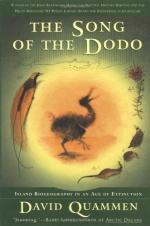
|
| Name: _________________________ | Period: ___________________ |
This test consists of 15 multiple choice questions and 5 short answer questions.
Multiple Choice Questions
1. What does Quammen say was found to play a role in the minimum viable population?
(a) A species' breeding habits.
(b) A species' typical number of offspring.
(c) A species' environment.
(d) A species' genetic history.
2. What incident does Quammen relate at the end of chapter nine, "World in Pieces"?
(a) Hiding from poachers in Tanzania.
(b) A thunderstorm rolling through in Mexico.
(c) Being mugged in Brazil.
(d) Mourning Bedo in Mauritius.
3. What national disaster destroyed kestrel habitat in Mauritius?
(a) A cyclone.
(b) A tornado.
(c) An earthquake.
(d) A tsunami.
4. What environment is NOT analogous to an island, according to Quammen?
(a) Mountaintop.
(b) Lake.
(c) Savannah.
(d) Cave.
5. Who is Thomas Lovejoy?
(a) Director of the World Wildlife Fund.
(b) Director of the Sierra Club.
(c) Director of National Parks in the U.S.
(d) Director of conservation in the U.S. government.
6. Who is Bedo?
(a) A local hunter.
(b) An indri researcher.
(c) Quammen's guide.
(d) Someone Quammen met in the hotel.
7. What condition would help a species breed out harmful genes?
(a) Inbreeding.
(b) Exposure to many similar species.
(c) Widespread breeding.
(d) Isolation.
8. How did Quammen make his way to this site?
(a) On foot.
(b) By ascending a rope.
(c) By boat.
(d) By descending into a cave.
9. How many indri are living in the forests Quammen visited?
(a) Hundreds.
(b) No one knows.
(c) Tens.
(d) Thousands.
10. What does Quammen believe happened to Bedo?
(a) He made people angry by raising consciousness as he talked with people from many different walks of life.
(b) He made enemies among the hunters.
(c) He made people uncomfortable being around white people a lot of the time.
(d) He made people jealous with the money he was making as a guide.
11. What is the tone of the final chapter?
(a) Dire.
(b) Portentous.
(c) Optimistic.
(d) Foreboding.
12. How many individuals were thought to be required for long-term genetic adaptability?
(a) 500.
(b) 5,000.
(c) 50.
(d) 200.
13. Why were people cutting down the forests in the place where Lovejoy implemented his plan?
(a) To mine resources.
(b) To build cities.
(c) To make wildlife extinct.
(d) To make rangeland.
14. What was Thomas Lovejoy's interest in the debate about the size of reserves and the number of species they support?
(a) He was in charge of determining whether species were endangered.
(b) He was in charge of creating natural reserves.
(c) He was in charge of setting conservation policy.
(d) He was in charge of government policy on forestry.
15. What factor did NOT cause the decline of the kestrel population?
(a) Predators eating the kestrel eggs.
(b) Habitat loss.
(c) Insecticides.
(d) Feather collectors.
Short Answer Questions
1. What is the central message of Quammen's book?
2. What habitats did researchers have to examine in the Texas case?
3. What is the tone of the ending of the book?
4. How does Quammen distinguish the Mauritius kestrel from other species that might need to be saved?
5. Why, according to Quammen, is the theory of equilibrium important to science?
|
This section contains 589 words (approx. 2 pages at 300 words per page) |

|




